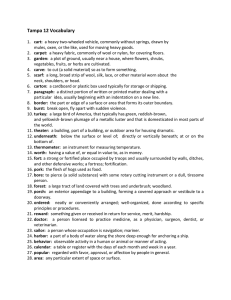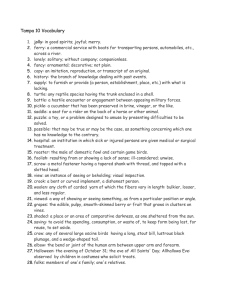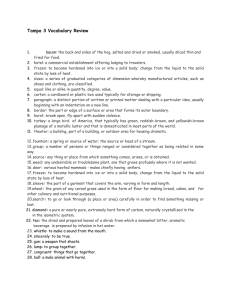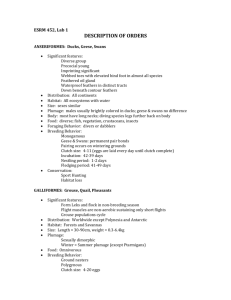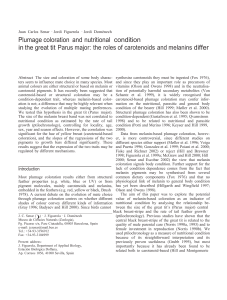two pieces of information in a single trait the yellow breast of the great tit (parus major) reflects both pigment acquisition and body condition.doc
advertisement
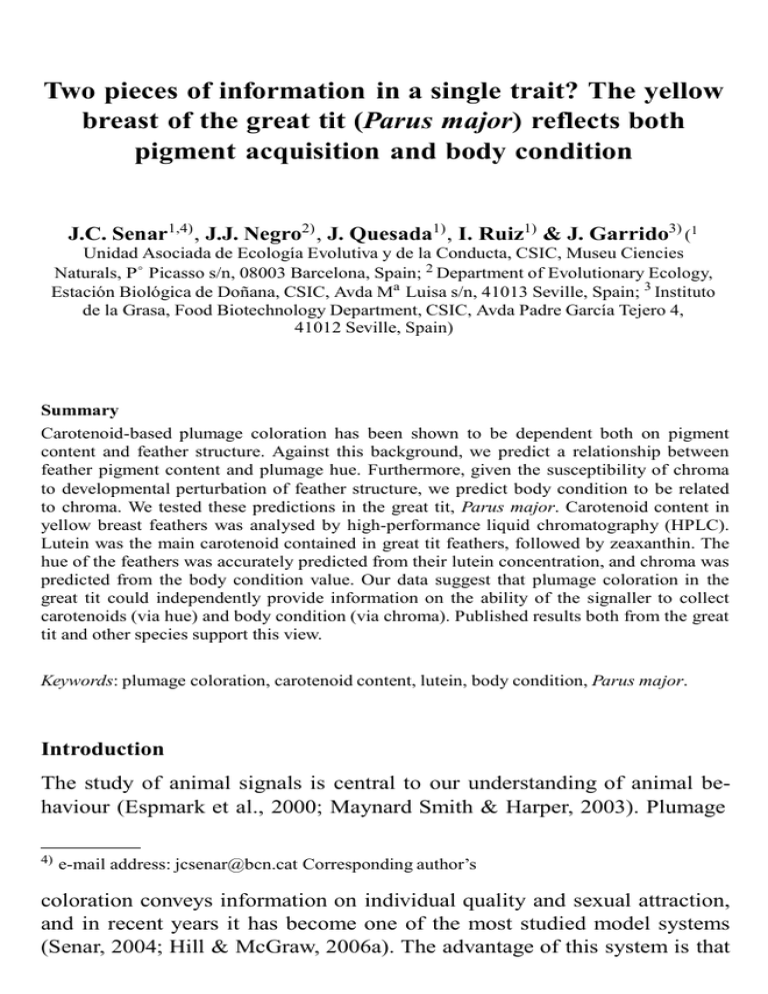
Two pieces of information in a single trait? The yellow breast of the great tit (Parus major) reflects both pigment acquisition and body condition J.C. Senar1,4) , J.J. Negro2) , J. Quesada1) , I. Ruiz1) & J. Garrido3) (1 Unidad Asociada de Ecología Evolutiva y de la Conducta, CSIC, Museu Ciencies Naturals, P◦ Picasso s/n, 08003 Barcelona, Spain; 2 Department of Evolutionary Ecology, Estación Biológica de Doñana, CSIC, Avda Ma Luisa s/n, 41013 Seville, Spain; 3 Instituto de la Grasa, Food Biotechnology Department, CSIC, Avda Padre García Tejero 4, 41012 Seville, Spain) Summary Carotenoid-based plumage coloration has been shown to be dependent both on pigment content and feather structure. Against this background, we predict a relationship between feather pigment content and plumage hue. Furthermore, given the susceptibility of chroma to developmental perturbation of feather structure, we predict body condition to be related to chroma. We tested these predictions in the great tit, Parus major. Carotenoid content in yellow breast feathers was analysed by high-performance liquid chromatography (HPLC). Lutein was the main carotenoid contained in great tit feathers, followed by zeaxanthin. The hue of the feathers was accurately predicted from their lutein concentration, and chroma was predicted from the body condition value. Our data suggest that plumage coloration in the great tit could independently provide information on the ability of the signaller to collect carotenoids (via hue) and body condition (via chroma). Published results both from the great tit and other species support this view. Keywords: plumage coloration, carotenoid content, lutein, body condition, Parus major. Introduction The study of animal signals is central to our understanding of animal behaviour (Espmark et al., 2000; Maynard Smith & Harper, 2003). Plumage 4) e-mail address: jcsenar@bcn.cat Corresponding author’s coloration conveys information on individual quality and sexual attraction, and in recent years it has become one of the most studied model systems (Senar, 2004; Hill & McGraw, 2006a). The advantage of this system is that we can concurrently investigate both the physiological mechanisms and the function of the signals (Hill & McGraw, 2006a,b). A key assumption in these studies is that plumage coloration relates to pigment type and concentration. The assumption of a relationship between plumage pigment content and plumage coloration is especially relevant within the context that relates plumage coloration to resource acquisition abilities (Olson & Owens, 1998). Furthermore, it is key to our understanding to what extent birds are really ‘what they eat’ (Hill, 1994) and to what extent there is a relationship between pigment acquisition and deposition, and plumage coloration (Hill, 2002). To date, this prediction has been tested in few species (Hill et al., 2002; Saks et al., 2003; McGraw & Gregory, 2004; McGraw et al., 2005). In all the previous studied species (Hill et al., 2002; Saks et al., 2003), carotenoid dietary precursors were metabolized, adding further complications to the relationships (e.g., energy demands, health status, etc.) (Stradi et al., 1996; Stradi, 1998; McGraw et al., 2006). Intuitively, a first and more simple step to this understanding would however be the study of species where the main feather carotenoid is directly deposited into the feather, with no metabolic transformation (Saks et al., 2003). In the great tit Parus major, the yellow of the breast feathers is mainly due to direct deposits of lutein and zeaxanthin, with no metabolic transformation occurring (Partali et al., 1987; Stradi, 1998). In this species, caterpillars are the main source of these carotenoids, especially lutein, which is preferentially absorbed from the leaves on which they feed (Partali et al., 1987; Grayson & Edmunds, 1989; Grayson et al., 1991). The ratio of lutein to zeaxanthin should, therefore, be higher in the plumage of birds with greater access to caterpillars (Partali et al., 1987; Ferns & Hinsley, 2008). Since lutein has peak absorbances at shorter wavelengths than zeaxanthin, a higher ratio of lutein to zeaxanthin should result in slightly shorter absorbed wavelengths. This, in turn, would decrease the dominant reflected wavelength, shifting it slightly towards the yellow–green as opposed to yellow–orange if zeaxanthin was dominant, thereby increasing plumage hue (Ferns & Hinsley, 2008). In addition to a difference in carotenoid metabolism, the relative low fit between carotenoid-based plumage coloration and feather carotenoid content found to date (e.g., greenfinch (Carduelis chloris): 32–51% (Saks et al., 2003); American goldfinch (Carduelis tristis): 62% (McGraw & Gregory, 2004)), suggests that some variation in plumage colour might be ascribed to other factors (Saks et al., 2003). Recent work has shown that carotenoidbased coloration is also dependent on the structure of the feather (Shawkey & Hill, 2005), which in turn depends on developmental stability and body condition (Fitzpatrick, 1998). Given that chroma is more susceptible to developmental perturbation of feather structure than is hue (Shawkey et al., 2003; Andersson & Prager, 2006; Prum, 2006), we could predict body condition to be related to chroma rather than to hue, which as predicted earlier, should be more dependent on pigment presence, specially in saturated colours (Andersson & Prager, 2006). If this were the case, it would support the recently suggested view that the different components of feather coloration may convey different units of information (Fitzpatrick, 1998; Johnsen et al., 2003; Shawkey & Hill, 2005; Ferns & Hinsley, 2008). Against this background, a single feather patch could potentially contain multiple ornaments (Candolin, 2003). The aim of this paper was to test for a relationship between plumage coloration and feather pigment content and body condition in the great tit (Parus major L.). The main carotenoids in feathers are deposited directly in this species, and as there is no metabolic transformation, the study of the relative contribution of both factors is simplified. We predicted that feathers with a higher lutein content would show a more yellow-green plumage coloration and hence a larger value of hue, and that body condition should be related to plumage chroma. We additionally introduced variables (sex, age and locality) that could affect both lutein accessibility and body condition (Carrascal et al., 1998; Senar et al., 2003; Hegyi et al., 2007; Ferns & Hinsley, 2008) so to standardize for their effect. Material and methods Great tits were trapped in baited funnel traps (Senar et al., 1997) in two contrasted habitats: Sarria, a suburban area of orchards and small mixed forest consisting of Holm oak (Quercus ilex) and Aleppo pines (Pinus halepensis), on the outskirts of Barcelona city, and Can Catà (Cerdanyola), a mixed forest close to Barcelona city consisting mainly of pure oak (Quercus ilex and Quercus cerrioides) at the bottom of the valleys and pure Aleppo pine forest in the hills. Age and sex of birds were determined according to Svensson (1992) and Jenni & Winkler (1994). Body condition was computed from the residuals of the regression of body mass on tarsus length (Brown, 1996). As body condition of the great tit has been shown to be consistent throughout the year (Gosler, 1991), condition at capture may well reflect condition during moult. The relationship between plumage colour and feather carotene content and individual body condition is based on a sample of birds trapped from September to November 2002 (N : Sarrià = 7, Can Catà = 29). Both plumage colour and carotene content in this sample were measured from collected feathers. The relationship between plumage colour and body condition was additionally analysed in a sample of 1141 great tits trapped during the years 2000 to 2006 (N : Sarrià = 168, Can Catà = 973). No feathers were collected from these birds. Plumage colour measurement Plumage colour in the 2002 sample was measured on collected feathers which were later analysed for carotene content. We collected a mean of 11.9 (S.E. 0.61) yellow feathers from each bird from the upper left side of the flank, standardising in this way the position for feather collection. In the laboratory, several layers of feathers from each individual were superimposed on a dark velvet surface (absolute reflectance 0%), in an attempt to replicate the plumage of the bird (Bennett et al., 1997; Quesada & Senar, 2006). A portable colorimeter Minolta CR200 (Minolta, 1994) was then used to measure colour in standard conditions (Figuerola et al., 1999). This method has previously been shown to be accurate when the number of feathers measured is included as a covariate in analyses (Quesada & Senar, 2006). We also included variables (sex, age and locality) to standardize for possible effects. Hue corresponds to the wavelength of the colour and is expressed in degrees of a circle starting with red, continuing through yellow, green and blue and back to red. In the case of great tits, hue values increase from an orange-yellow to a greenish yellow. Lightness corresponds to the physical light intensity on a scale from 0 (black) to 100 (white). Chroma (also called saturation or intensity) is positively correlated with colour purity on a scale of 0 for white to 100 for pure colour (Minolta, 1994; Fairchild, 2005). Measuring colour with a colorimeter provided highly repeatable measures of yellow coloration: lightness, ri = 0.85, p < 0.001; chroma, ri = 0.87, p < 0.001; hue, ri = 0.92, p < 0.001; N = 12 (Figuerola et al., 1999) (repeatability measured as the intraclass correlation between two independent measurements from the same bird, with feathers being arranged anew before taking the repeat measurement (Lessells & Boag, 1987; Harper, 1994)). Our colorimeter measures colour in the visible range (400–700 nm), but does not collect the UV range (320–400 nm). However, both empirical results (Senar & Quesada, 2006) and theoretical simulations (Andersson & Prager, 2006, Fig. 2.11, p. 81) show that the reflectance of the UV peak (300–400 nm) of great tit breast feathers is highly correlated with the peak of the yellow–red spectrum (500–700 nm), so that collecting only the visible part of the spectrum in the great tit does not suppose any bias in our results (although this may be different in other species (Mays et al., 2004)). Plumage coloration from the extended (2000–2006) sample of great tits was measured from the birds in the field using the same portable colorimeter (Minolta CR200), and taking the measurement from the upper left portion of the yellow breast (Figuerola et al., 1999). Given the extended sampling period of this sample, analyses of variation in plumage coloration was carried out introducing the number of days from 1 September (date) as a covariant, to standardize for seasonal effects on plumage coloration (Figuerola & Senar, 2005), and biological year as a factor, to standardize for inter-year variation in plumage colour (Senar & Quesada, 2006). Extraction of feather pigments Extraction of carotenoids from feathers was carried out by J. Garrido at the Instituto de la Grasa Laboratory, following Blanco et al. (2005): a 0.005– 0.0012 g sample of breast feathers (ca. 12 feathers) was placed in a folded filter paper and introduced into a 10 ml test tube for subsequent extraction. N,N-dimethylformamide (10 ml) was added and the tube was placed at 60◦ C for 60 min, followed by sonication for 5 min every 30 min. All fractions were pooled in a decanting funnel and treated with 50 ml diethyl ether to collect the pigments. 10% NaCl was added to facilitate separation of the phases. The ether phase was filtrated through anhydrous sodium sulphate, evaporated in a rotary evaporator until sample dryness, and resuspended in 0.2 ml of acetone. The resulting extracts were stored at −20◦ C until analysis by high-performance liquid chromatography (HPLC). Quantitative determination of carotenoids HPLC was carried out at the Molecular Ecology Laboratory of Doñana Biological Station using a Jasco PU-2089 Plus instrument equipped with a quaternary pump (Jasco Analítica Spain). Carotenoid analyses were carried out by using a reverse phase C18 column (Phenomenex Synergi 4 μ) and a precolumn of the same material with a particle size of 5 μm. Samples were pre-filtered using OEM filter Nylon 0.45 μm 4 mm and later injected with a Rheodyne 7725i valve equipped with a 20 μl loop (Rheodyne, Rohnent Park, CA, USA). The eluent system was a gradient described in MínguezMosquera & Hornero-Méndez (1993), except that the flow rate was 1 ml min−1 . Data were acquired between 195 nm and 650 nm with a multiwavelength detector MD-2010 Plus (Jasco Analítica Spain). Carotenoids were quantified using reference lutein obtained from fresh green plants by means of thin layer chromatography (Mínguez-Mosquera, 1997). Known dilutions of lutein were injected in the HPLC instrument to build a calibration curve at 450 nm. The concentration of individual carotenoids was calculated from HPLC areas recorded at 450 nm. Results The main carotenoid contained in great tit feathers was lutein (Table 1). Birds also contained variable quantities of zeaxanthin. Cryptoxanthin was found in only one bird (17.2 μg/g). We additionally found a suite of other carotenoids in trace amounts that we were unable to identify. Hue was not correlated to chroma (r = 0.04, p = 0.82) or lightness (r = 0.08, p = 0.65), but chroma was correlated to lightness (r = 0.45, p < 0.01, N = 36). Hue of the feathers was accurately predicted from their lutein content (Table 2, Figure 1). Zeaxanthin content was not a good predictor of apparent Table 1. Content (μg/g) of different carotenoids in the breast feathers of great tits N = 36. Lutein Zeaxanthin Non-identified Mean S.E. Minimum Maximum 52.7 2.0 8.9 6.1 0.5 1.5 0.0 0.0 0.0 144.4 9.2 27.0 Table 2. Summary of the multiple regression for the relationship between hue of feathers and locality (Sarriá vs. Can Catà), sex, age (Yearlings vs. Adults), number of feathers used in measurement, body condition (residual of regression between body mass and tarsus length), lutein (μg/g) and zeaxanthin (μg/g) content of the feathers (N = 36 great tits). R2 Partial correlation Slope SE slope F df Hue Locality 0.12 Sex 0.17 Age 0.03 Body condition 0.01 No. feathers −0.17 Lutein 0.19 Zeaxanthin 0.00 0.43 0.53 0.23 0.13 −0.51 0.54 0.05 2.69 2.02 0.82 0.21 −0.28 0.03 0.03 1.07 0.62 0.64 0.30 0.09 0.01 0.11 6.37 10.73 1.63 0.51 10.08 11.33 0.07 1, 28 1, 28 1, 28 1, 28 1, 28 1, 28 1, 28 <0.05 <0.01 0.21 0.48 <0.01 <0.01 0.80 Final model Locality Sex No. feathers Lutein 0.45 0.51 −0.52 0.53 2.73 1.96 −0.29 0.03 0.98 0.60 0.08 0.01 8.80 7.77 10.75 11.31 12.26 4, 31 1, 31 1, 31 1, 31 1, 31 <0.001 <0.01 <0.01 <0.01 <0.01 0.53 0.12 0.16 −0.18 0.19 p level The final best model obtained from backwards stepwise regression describing hue of the feathers is also included. Figure 1. Relationship between the hue of the collected great tit yellow breast feathers (standardized by regression for the effect of collateral variables locality, sex and number of feathers) and lutein content. hue. Neither did the ratio of lutein to zeaxanthin allow to predict plumage hue (partial r = 0.11, p = 0.58). Other variables additionally predicting hue were the sex and locality of the birds. Body condition was not a good predictor of hue (Table 2). Inclusion of non-identified carotenoids in the models did not change results. Repeating the analyses for the sex and population with the largest sample, the males at Can Catà, we obtained the same results: the hue of the feathers was predicted from their lutein content (partial r = 0.63, p < 0.01). Plumage chroma was accurately predicted from the individual body condition values (Figure 2), but carotenoid content did not have any effect on this parameter of plumage coloration, either as absolute values (Table 3) or as the ratio of lutein to zeaxanthin (partial r = −0.07, p = 0.73). Repeat analyses for the sex and population in the largest sample, Can Catà males, showed a similar effect size, but did not reach significance (chroma vs. body condition: partial r = 0.32, p = 0.19). However, when we performed a GLIM analysis using data from both populations from 2000 to 2006, the effect of body condition on chroma was significant (Table 4). In contrast, no relationship was found between hue and body condition (F1,1083 = 2.31, p = 0.13). Zeaxanthin content marginally predicted plumage lightness (Table 4). Interestingly, lutein content showed a negative relationship to plumage lightness (Table 5). The ratio of lutein to zeaxanthin allowed prediction of Figure 2. Relationship between the chroma of the collected great tit yellow breast feathers (standardized by regression for the effect of sex) and body condition (as estimated from residuals of the regression of body mass to tarsus length). Table 3. Summary of the multiple regression for the relationship between chroma of the feathers and locality, sex, age, number of feathers used in measurement, body condition, lutein (μg/g) and zeaxanthin (μg/g) content of the feathers (N = 36 great tits). R2 Partial correlation Slope SE slope F df p level Chroma Locality Sex Age Body condition No. feathers Lutein Zeaxanthin 0.01 0.18 0.01 0.12 0.01 0.07 0.00 0.08 0.45 0.12 0.36 0.12 −0.29 0.03 1.51 5.60 1.43 2.07 0.19 −0.05 0.05 3.60 2.08 2.16 1.01 0.30 0.03 0.38 0.18 7.24 0.44 4.20 0.41 2.52 0.02 1, 28 1, 28 1, 28 1, 28 1, 28 1, 28 1, 28 0.68 <0.05 0.51 <0.05 0.53 0.12 0.89 Final model Sex Body condition 0.22 0.15 0.09 0.40 0.33 5.15 1.81 1.98 0.88 5.00 6.75 4.26 2, 36 1, 36 1, 36 0.01 <0.05 <0.05 The final best model obtained from backwards stepwise regression describing chroma of the feathers is also included. plumage lightness (partial r = −0.31, p = 0.11) that was similar to the use of absolute zeaxanthin content. Discussion Carotenoids cannot be synthesized by animals and must be ingested in the diet (Fox, 1976). Caterpillars are the main source of carotenoids for tits (Slagsvold & Lifjeld, 1985), and once ingested, the pigments are deposited unmodified inside feathers (Partali et al., 1987). A brightly carotenoidcoloured tit could, therefore, be signalling its ability to find caterpillars (Ferns & Hinsley, 2008), a main food source for both adults and fledglings (Gosler, 1993), and hence, it would be of direct female benefit to pair with a brightly coloured male (Senar et al., 2002). However, if plumage colour in tits signals their ability to find caterpillars, yellow plumage must relate to pigment content (Ferns & Hinsley, 2008). Caterpillars obtain carotenoids from the leaves on which they feed (Grayson & Edmunds, 1989; Grayson et al., 1991). However, they have been shown to preferentially absorb lutein (Partali et al., 1987). As a consequence, Table 4. Summary of the GLIM analysis for the relationship between chroma of the breast feathers and date in which the bird was measured (days from 1 September), body condition, locality (Sarria vs. Can Catà), year (2000– 2006), sex and age (Yearlings vs. Adults) of the birds (N = 1.141 great tits). Date Body condition Locality Year Sex Age Loc × Year Loc × Sex Year × Sex Loc × Age Year × Age Sex × Age Loc × Year × Sex Loc × Year × Age Loc × Sex × Age Year × Sex × Age Loc × Year × Sex × Age df F p 1, 1083 1, 1083 1, 1083 6, 1083 1, 1083 1, 1083 6, 1083 1, 1083 6, 1083 1, 1083 6, 1083 1, 1083 6, 1083 6, 1083 1, 1083 6, 1083 6, 1083 10.38 10.99 34.87 14.15 8.27 7.24 3.08 7.01 1.26 0.01 2.21 0.15 2.25 2.15 0.39 1.08 0.49 <0.01 <0.001 <0.001 <0.001 <0.01 <0.01 <0.01 <0.01 0.27 0.94 <0.05 0.70 <0.05 <0.05 0.53 0.37 0.82 Table 5. Summary of the multiple regression for the relationship between lightness of the feathers and locality, sex, age, number of feathers used in measurement, body condition, lutein (μg/g) and zeaxanthin (μg/g) content of the feathers (N = 36 great tits). Lightness Locality Sex Age Body condition N◦ feathers Lutein Zeaxanthin R2 Partial correlation Slope SE slope F df p level 0.00 0.07 0.01 0.00 0.00 0.06 0.12 0.04 0.28 0.12 0.06 0.06 −0.25 0.34 0.35 1.56 0.69 0.16 0.05 −0.02 0.36 1.76 1.02 1.05 0.49 0.15 0.01 0.19 0.04 2.35 0.42 0.11 0.10 1.87 3.74 1, 28 1, 28 1, 28 1, 28 1, 28 1, 28 1, 28 0.84 0.14 0.52 0.74 0.75 0.18 0.06 Backwards stepwise regression did not provide any final model. the ratio of lutein to zeaxanthin should be higher in the plumage of birds with a greater access to caterpillars (Partali et al., 1987; Ferns & Hinsley, 2008) (note that although Partali et al. (1987) refer to absolute values, their Table 2 shows that it is in fact the relative value of lutein to zeaxanthin which varies). Lutein has also been found to be the main carotenoid in the plasma of great tits (Hörak et al., 2004). Lutein has peak absorbances at relatively shorter wavelengths than zeaxanthin. In our HPLC system (see Methods), peak absorbances for lutein were at 448 nm and 476 nm, whereas those for zeaxanthin were at 456 nm and 480 nm. Therefore, we should predict that a higher proportion of lutein to other carotenoids in feathers should result in slightly shorter absorbed wavelengths. This would, in turn, decrease the dominant reflected wavelength, shifting it slightly towards the yellow–green, thus increasing the hue of plumage coloration (Ferns & Hinsley, 2008). Contrary to our prediction, it was the absolute concentration of lutein in feathers, rather than the ratio of lutein to zeaxanthin, which correlated to the hue of the plumage of great tits. However, this may have been a statistical artifact caused by the 25 times higher abundance of lutein compared to zeaxanthin (Table 1). As the zeaxanthin concentration was relatively low, measurements were likely inaccurate, in which case estimates of the ratio between the two pigments would also be imprecise. Thus, as a positive correlation between the (true) absolute and relative lutein concentration was likely, and because the absolute concentration was measured with much less error, only the first is significantly correlated with hue. Indeed, as Table 2 shows that feathers with higher hue contained more lutein, but not more zeaxanthin, the ratio between lutein and zeaxanthin should be higher in feathers with higher hue. Our biochemical results hence support that hue in tits could be an indicator of an individual’s ability to locate carotenoid-rich food sources, and by extension, of an individual’s ability to obtain scarce resources (Ferns & Hinsley, 2008). It is noteworthy that the hue of the cere and legs in kestrels (Falco tinnunculus) also relates to their foraging ability (Casagrande et al., 2006). The fact that it is the hue of plumage coloration which is related to the width of tail growth bars in tits (a measure of higher foraging efficiency (Senar et al., 2003)) and to nest provisioning rates and growth rate of the nestlings (a measure of parental investment via foraging efficiency (Senar et al., 2002)), additionally supports this view. Thus, we can state that plumage hue is a good predictor of lutein content in the feathers of great tits and a consequence of an individual’s ability to find and ingest carotene-rich foods such as caterpillars, a high-quality food source for both adults and fledglings (Gosler, 1993). As outlined in the introduction, carotenoid-based coloration does not only depend on pigment content but also on the structure of the feather (Shawkey & Hill, 2005). Since body condition has an effect on feather structure and developmental stability, and since chroma is highly susceptible to developmental perturbation of feather structure, we predicted chroma value of the feathers to be related to the bird’s body condition (Fitzpatrick, 1998; Shawkey et al., 2003; Shawkey & Hill, 2005; Prum, 2006). Our findings confirmed this prediction. A relationship between yellow breast chroma and condition has also been described for the Blue Tit Parus caeruleus (Johnsen et al., 2003). This is also consistent with the recent finding that great tit chroma is related to timing of moult (Ferns & Hinsley, 2008), which in turn is related to the general body condition of the bird (Jenni & Winkler, 1994). The relationship found between chroma and body condition assumes that condition of the bird at capture is correlated with condition during moult. Earlier data from the great tit supports this notion (Gosler, 1991), strengthening our present results. Intuitively, we should additionally find a relationship of chroma to pigment concentration (Shawkey & Hill, 2005; Andersson & Prager, 2006), but our data do not support this view. This contrasts with data from other species (greenfinch and American goldfinch), in which chroma has, in fact, also been related to pigment content (Saks et al., 2003; McGraw & Gregory, 2004). Theoretical models suggest that when chroma is positively correlated to lightness (i.e., colour is saturated), as in the case of our great tits (r = 0.45, p < 0.01), chroma should not relate to pigment concentration (Andersson & Prager, 2006). This could explain our results. However, more research is needed to fully understand the inter-specific variation in the relationship between chroma and pigment concentration. We found, in addition to carotenoid content and body condition, other independent factors such as locality and sex appear to affect plumage coloration. This is not surprising, since it has been found that caterpillar availability and hence carotenoid content differ between localities (Slagsvold & Lifjeld, 1985; Eeva et al., 2000; Isaksson et al., 2005) and sexes differ in dominance status and body condition (Carrascal et al., 1998; Senar et al., 2003). If females are the choosing sex and if they have preference for brighter colored males (Hill & McGraw, 2006), sexual dimorphism with respect to plumage coloration will evolve. This also explains differences in coloration between the sexes. Additionally, other aspects of feather structure unrelated to lutein content or body condition, such as feather abrasion (Figuerola & Senar, 2005), soil (Surmacki & Nowakowski, 2007) or uropygial gland secretions (Galvan & Sanz, 2006), could affect plumage coloration to different degrees in relation to habitat or sex. This may explain why we are still unable to capture most of the variation in plumage coloration Finally, we want to emphasize that data from great tits clearly show that plumage coloration in this species could independently provide information on body condition (via chroma) and on ability to locate carotenoid-rich food sources (via hue) (see also Ferns & Hinsley, 2008). Although further experimental work is needed, available data supports the view of the multiple message hypothesis conveyed by carotenoid-based plumage coloration (Fitzpatrick, 1998; Johnsen et al., 2003; Badyaev & Young, 2004; Shawkey & Hill, 2005), so that single feather patches could potentially behave as multiple ornaments (Wedekind et al., 1998; Candolin, 2003) Acknowledgements We thank Lluïsa Arroyo for measuring plumage colour in the laboratory and Isabel García for measuring carotenoid content in feathers. We also thank Kevin McGraw for critically reading an early version of this paper, Riccardo Stradi for earlier discussions on the topic and the paper, and Carolyn Newey for improving the English. We are also grateful to Leopoldo Gil for allowing us to work in Can Catà. CGL2006-07481 project to JCS, JJN and JG from Ministerio de Ciencia y Tecnología and grants FPI2000-0014 to IR (CIRIT, Generalitat de Catalunya) and FP2000-6439 to JQ (Ministerio de Ciencia y Tecnología), funded this work. References Andersson, S. & Prager, M. (2006). Quantifying colors. — In: Bird coloration, vol. 2. Function and evolution (Hill, G.E. & McGraw, K.J., eds). Harvard University Press, Cambridge, MA, p. 41-89. Badyaev, A.V. & Young, R.L. (2004). Complexity and integration in sexual ornamentation: an example with carotenoid and melanin plumage pigmentation. — J. Evol. Biol. 17: 1317-1327. Bennett, A.T.D., Cuthill, I.C., Partridge, J.C. & Lunau, K. (1997). Ultraviolet plumage colors predict mate preferences in starlings. — Proc. Natl. Acad. Sci. USA 94: 8618-8621. Blanco, G., Frías, O., Garrido, J. & Hornero, D. (2005). Environmental-induced acquisition of nuptial plumage expression: a role of denaturation of feather carotenoproteins? — Proc. Roy. Soc. Lond. B: Biol. 272: 1893-1900. Brown, M.E. (1996). Assessing body condition in birds. — Curr. Ornithol. 13: 67-135. Candolin, U. (2003). The use of multiple cues in mate choice. — Biol. Rev. 78: 575-595. Carrascal, L.M., Senar, J.C., Mozetich, I., Uribe, F. & Domènech, J. (1998). Interactions among environmental stress, body condition, nutritional status, and dominance in great tits. — Auk 115: 727-738. Casagrande, S., Csermely, D., Pini, E., Bertacche, V. & Tagliavini, J. (2006). Skin carotenoid concentration correlates with male hunting skill and territory quality in the kestrel Falco tinnunculus. — J. Avian Biol. 37: 190-196. Eeva, T., Tanhuanpää, S., Rabergh, C., Airaksinen, S., Nikinmaa, M. & Lehikoinen, E. (2000). Biomarkers and fluctuating asymmetry as indicators of pollution-induced stress in two hole-nesting passerines. — Funct. Ecol. 14: 235-243. Espmark, Y.O., Amundsen, T. & Rosenqvist, G. (2000). Animal signals. Signalling and signal design in animal communication. — Tapir Academic Press, Trondheim. Fairchild, M.D. (2005). Color appearance models. — Wiley, Chichester. Ferns, P.N. & Hinsley, S.A. (2008). Carotenoid plumage hue and chroma signal different aspects of individual and habitat quality in tits. — Ibis 150: 152-159. Figuerola, J., Pascual, J. & Senar, J.C. (1999). The use of a colorimeter in field studies of Blue Tit Parus caeruleus coloration. — Ardea 87: 269-275. Figuerola, J. & Senar, J.C. (2005). Seasonal changes in carotenoid- and melanin-based plumage coloration in the great tit Parus major. — Ibis 147: 797-802. Fitzpatrick, S. (1998). Colour schemes for birds: structural coloration and signals of quality in feathers. — Ann. Zool. Fennici 35: 67-77. Fox, D.L. (1976). Animal biochromes and structural colours. — University of California Press, Berkeley, CA. Galvan, I. & Sanz, J.J. (2006). Feather mite abundance increases with uropygial gland size and plumage yellowness in great tits Parus major. — Ibis 148: 687-697. Gosler, A.G. (1991). On the use of greater covert moult and pectoral muscle as measures of body condition in passerines with data from the great tit Parus major. — Bird Study 38: 1-9. Gosler, A.G. (1993). The great tit. — Hamlyn, London. Grayson, J. & Edmunds, M. (1989). The causes of colour and colour change in caterpillars of the poplar and eyed hawkmoths (Laothoe populi and Smerinthus ocellata). — Biol. J. Linn. Soc. 37: 263-279. Grayson, J., Edmunds, M. & Evans, E.H. (1991). Carotenoids and colouration of poplar hawkmoth caterpillars (Laothoe populi). — Biol. J. Linn. Soc. 42: 457-465. Harper, D.G.C. (1994). Some comments on the repeatability of measurements. — Ringing & Migration 15: 84-90. Hegyi, G., Szigeti, B., Török, J. & Eens, M. (2007). Melanin, carotenoid and structural plumage ornaments: information content and role in great tits Parus major. — J. Avian Biol. 38: 698-708. Hill, G.E. (1994). House finches are what they eat: a reply to Hudon. — Auk 111: 221-225. Hill, G.E. (2002). A red bird in a brown bag. — Oxford University Press, Oxford. Hill, G.E., Inouye, C.Y. & Montgomerie, R. (2002). Dietary carotenoids predict plumage coloration in wild house finches. — Proc. R. Soc. Lond. B: Biol. 271: 1033-1038. Hill, G.E. & McGraw, K.J. (2006a). Bird coloration, vol. 2. Function and evolution. — Harvard University Press, Cambridge, MA. Hill, G.E. & McGraw, K.J. (2006b). Bird coloration, vol. 1. Mechanisms and measurements. — Harvard University Press, Cambridge, MA. Hörak, P., Surai, P.F., Ots, I. & Moller, A.P. (2004). Fat soluble antioxidants in brood-rearing great tits Parus major: relations to health and appearance. — J. Avian Biol. 35: 63-70. Isaksson, C., Örnborg, J., Stephensen, E. & Andersson, S. (2005). Plasma Glutathione and Carotenoid coloration as potential biomarkers of environmental stress in great tits. — EcoHealth 2: 138-146. Jenni, L. & Winkler, R. (1994). Moult and ageing of European passerines. — Academic Press, London. Johnsen, A., Delhey, K., Kempenaers, B. & Anderson, S. (2003). Plumage colour in nestling blue tits: sexual dichromatism, condition dependence and genetic effects. — Proc. Roy. Soc. Lond. B: Biol. 270: 1263-1270. Lessells, C.M. & Boag, P.T. (1987). Unrepeatable repeatabilities: a common mistake. — Auk 104: 116-121. Maynard Smith, J. & Harper, D. (2003). Animal signals. — Oxford University Press, Oxford. Mays, H.L., McGraw, K.J., Ritchison, G., Cooper, S., Rush, V.N. & Parker, R.S. (2004). Sexual dichromatism in the yellow-breasted chat Icteria virens: spectrophotometric analysis and biochemical basis. — J. Avian Biol. 35: 125-134. McGraw, K.J. & Gregory, A.J. (2004). Carotenoid pigments in male American goldfinches: what is the optimal biochemical strategy for becoming colourful? — Biol. J. Linn. Soc. 83: 273-280. McGraw, K.J., Nolan, P.M. & Crino, O.L. (2006). Carotenoid accumulation strategies for becoming a colourful House Finch: analyses of plasma and liver pigments in wild moulting birds. — Funct. Ecol. 20: 678-688. McGraw, K.J., Safran, R.J. & Wakamatsu, K. (2005). How feather colour reflects its melanin content. — Funct. Ecol. 19: 816-821. Mínguez-Mosquera, M.I. (1997). Clorofilas y carotenoides en tecnología de alimentos. — Secretariado de Publicaciones de la Universidad de Sevilla, Sevilla. Minguez-Mosquera, M.I. & Hornero-Mendez, D. (1993). Separation and quantification of the carotenoid pigments in red peppers (Capsicum annuum L.), paprika, and oleoresin by reversed-phase HPLC. — J. Agric. Food Chem. 41: 1616-1620. Minolta (1994). Precise color communication: color control from feeling to instrumentation. — Minolta, Osaka. Olson, V.A. & Owens, I.P.F. (1998). Costly sexual signals: are carotenoids rare, risky or required? — Trends Ecol. Evol. 13: 510-514. Partali, V., Liaaen-Jensen, S., Slagsvold, T. & Lifjeld, J.T. (1987). Carotenoids in food chain studies — II. The food chain of Parus spp. monitored by carotenoid analysis. — Comp. Biochem. Physiol. 87B: 885-888. Prum, R.O. (2006). Anatomy, physics, and evolution of structural colors. — In: Bird coloration, vol. 1. Mechanisms and measurements (Hill, G.E. & McGraw, K.J., eds). Harvard University Press, Cambridge, MA, p. 295-353. Quesada, J. & Senar, J.C. (2006). Comparing plumage colour measurements obtained directly from live birds and from collected feathers: the case of the great tit. — J. Avian Biol. 37: 609-616. Saks, L., McGraw, K.J. & Hörak, P. (2003). How feather colour reflects its carotenoid content. — Funct. Ecol. 17: 555-561. Senar, J.C. (2004). Mucho más que plumas. — Monografies del Museu de Ciències Naturals, vol. 2, Barcelona. Senar, J.C., Figuerola, J. & Domènech, J. (2003). Plumage coloration and nutritional condition in the great tit Parus major: the roles of carotenoids and melanins differ. — Naturwissenschaften 90: 234-237. Senar, J.C., Figuerola, J. & Pascual, J. (2002). Brighter yellow blue tits make better parents. — Proc. Roy. Soc. Lond. B: Biol. 269: 257-261. Senar, J.C. & Quesada, J. (2006). Absolute and relative signals: a comparison between melanin- and carotenoid-based patches. — Behaviour 143: 589-595. Shawkey, M.D., Estes, A.M., Siefferman, L.M. & Hill, G.E. (2003). Nanostructure predicts intrapecific variation in ultraviolet-blue plumage colour. — Proc. Roy. Soc. Lond. B: Biol. 270: 1455-1460. Shawkey, M.D. & Hill, G.E. (2005). Carotenoids need structural colours to shine. — Biol. Lett. 1: 121-124. Slagsvold, T. & Lifjeld, J.T. (1985). Variation in plumage colour of the great tit Parus major in relation to habitat, season and food. — J. Zool. Lond. 206: 321-328. Stradi, R. (1998). The colour of flight: carotenoids in bird plumage. — Solei Press, Milan. Stradi, R., Rossi, E., Celentano, G. & Bellardi, B. (1996). Carotenoids in bird plumage: the pattern in three Loxia species and in Pinicola enucleator. — Comp. Biochem. Physiol. 113: 427-432. Surmacki, A. & Nowakowski, J. (2007). Soil and preen waxes influence the expression of carotenoid-based plumage coloration. — Naturwissenschaften 94: 829-835. Svensson, L. (1992). Identification guide to European passerines. — Svensson, Stockholm. Wedekind, C., Meyer, P., Frischknecht, M., Niggli, U.A. & Pfander, H. (1998). Different Carotenoids and Potential information content of red coloration of male three-spined stickleback. — J. Chem. Ecol. 25: 787-801.


